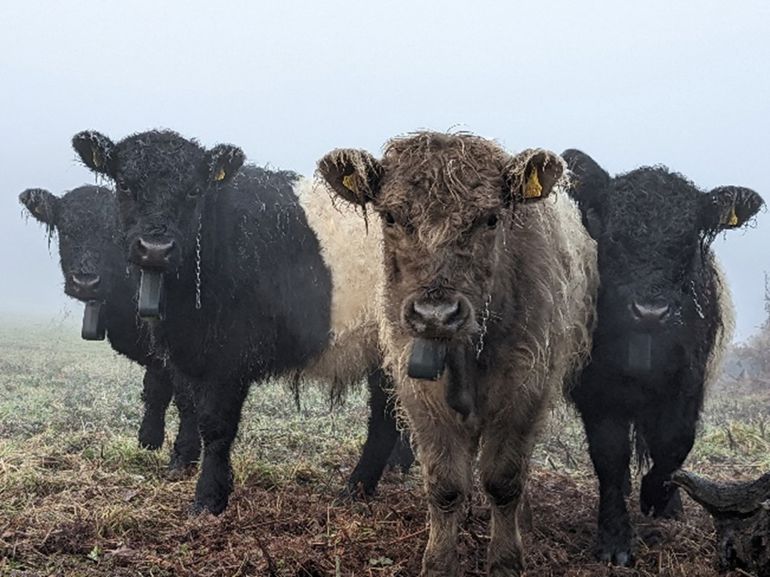Meet the bog-trotting superstars helping to restore valuable heath and bog habitat in Monmouthshire

An exciting new restoration project between Natural Resources Wales (NRW) and the Wye Valley Area of Outstanding Natural Beauty (AONB) will help to restore valuable heath and bog habitats in Monmouthshire, south Wales.
Cleddon Bog, a Site of Special Scientific Interest (SSSI) and Beacon Hill in the Wye Valley, provide a valuable habitat for a range of wildlife and rare plants and require careful management to prevent scrub from taking over the land.
As part of the vital work to restore the habitat at both sites, four Belted Galloway cattle – named Ringo, Penguin, Ginger and Oak are being brought in to graze the land, which will help to restore the rare habitats by opening up the bog and heathland landscapes for wildlife.
The site at Beacon hill is a nationally important lowland heathland and one that supports a range of increasingly rare and vulnerable wildlife, including heathers, Bilberry, Heath Bedstraw, Eyebright and Lousewort.
It is also home to the secretive Nightjar that can be seen and heard on the heathland during the spring and summer months. It requires active management to keep the scrubby vegetation such as bracken, bramble and birch from encroaching, leading to the loss of this valuable habitat.
Areas of the heathland have been cleared over the past few years and introducing grazing to the site is an important part of the positive management of a diverse heathland habitat.
Grazing with cattle is an important management tool as they selectively graze the heathland plants and browse some of the invading birch scrub, helping to maintain a healthy balance between the habitat types.
Cleddon Bog is home to a number of unusual plant species, including bog asphodel and round-leaved sundew, a carnivorous, insect eating plant. The bog also supports a number of insects, which make perfect dining for species like bats.
As a peat bog, it helps to play a vital role in tackling climate change by locking away carbon as well as helping to regulate flood flows for the local community. Over the last 20 years, the water levels at the bog have dropped, and plants that prefer drier conditions, such as purple moor grass and birch have become more dominant, speeding up the drying process.
The Belted Galloway cattle have been brought in to graze the land and will help to control the scrub and crush the dominant vegetation, allowing the sphagnum and other special bog plants, and giving the wildlife that depend upon them, a chance to thrive.
In partnership with the Wye Valley AONB, ten local volunteers have been brought in and trained as ‘lookers’ to monitor the cattle and ensure their health and welfare through regular visual checks. All the volunteers passed a LANTRA qualification in livestock checking (run by the Rare Breed Survival Trust) and have a rota to carry out the daily checks.
The project is being funded by a small peatlands grant from NRW. The cattle arrived at Cleddon bog for a trial period during March and will spend the Spring and Summer on the Beacon hill .
Rosalind Watkins, Senior Land Management Officer for Natural Resources Wales said:
This has been a great opportunity for NRW to work with the AONB on a very important and exciting project.
It has been a long-term aim to establish grazing at Cleddon Bog and Beacon hill as it is an important part of the positive management of both habitats. I look forward to seeing the benefits this partnership project will have on the condition of these valuable habitats.
Nickie Moore from Wye Valley Area of Outstanding Natural Beauty (AONB) said:
We are thrilled to be working with our partners at NRW and local Commoners on a landscape scale, with three grazing schemes connecting the heathlands with the peatland - at Beacon Hill and Broad Meend (NRW Forestry Estate), where local commoners have been successfully conservation grazing with ponies for a number of years, and Cleddon bog.
Alex Crawley from Conservation Grazing Management said:
We are looking forward to our belted Galloways, Ringo, Penguin, Ginger and Oak, grazing on Beacon Hill this year, helping to bring conservation benefits to this valuable and rare habitat. We have learnt much from the pilot at Cleddon Bog and will be bringing that experience to this new site. It has been lovely to see how much interest there has been in conservation grazing and its value to our challenged natural world.
For more information on the project please visit: Conservation Grazing at Cleddon Bog – Wye Valley AONB
